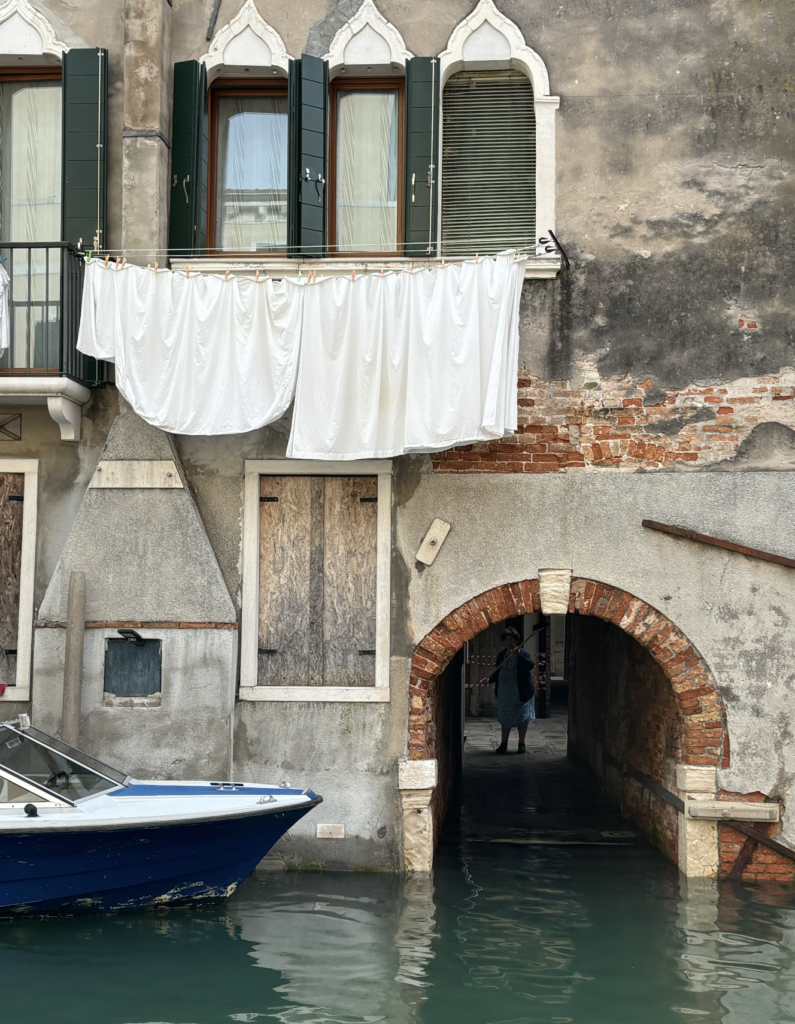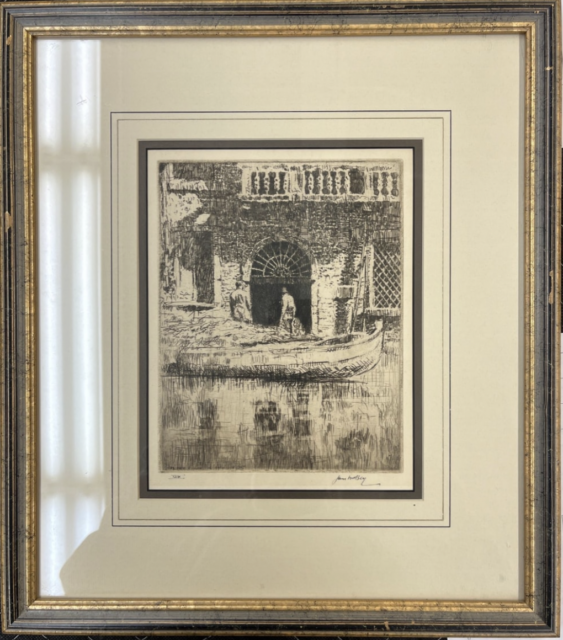James McBey (Scottish, 1883-1959)
The Doorway, 1925
Etching on paper
10.75 x 8.1875 in
Gift of John A. Welsh, III ’59
As I first began to browse the Van Every | Smith collections in search of artwork reminiscent of my semester abroad, I sought a piece with some kind of not merely Italian, but Florentine quality. Not necessarily a depiction of the city or a Renaissance work, but instead a piece with some trait that whispered Florence, the city where I spent four cherished months. I imagined that perhaps I would choose a portrayal of architecture which brought me back to my apartment, with its four flights of stairs, cool tile floors, and grand door requiring a comically large key, or maybe a still life which transported me back to my favorite restaurant, with its low vaulted ceilings, baskets piled high with rustic Tuscan bread, and dimly lit, warm ambience.
My inkling was natural: after all, I think of Florence often, sometimes in disbelief that I felt so well-suited to a city I had never before visited. What’s more, a decent portion of my sophomore year was marked by my quest for Florence, where I was categorically determined to spend the first semester of my junior year, and who could blame me? My Italian Renaissance Art course sparked an interest in the city which continued to crescendo as the year progressed. I considered spending my semester in other Italian cities, such as Rome, per the expertise of my Italian grandfather, but for me, in the end, it had to be Florence.
Imagine my surprise, then, when during my survey of the collection upon my return to Davidson, I found myself drawn not to a piece which had some implicit Florentine quality which brought me back to those pivotal four months in the birthplace of the Renaissance, but rather, by a portrayal of a different Italian city. Indeed, I was captivated by a depiction which is explicitly and fundamentally Venetian.
A fleeting glance at James McBey’s The Doorway was enough to bring me right back to the winding streets of Venice, with its charming bridges, charismatic gondoliers, and rich history.
I remember the stir of emotions I felt as the train approached the Venezia Santa Lucia Station for my first visit to Venice this past fall. We seemed to glide over the azure mirror of the water, visible from all angles. Perhaps Venice is especially memorable to me because despite my countless journeys on Trenitalia, Italy’s regional train line, this arrival felt especially profound. In fact, as we rode over the water, moments away from arriving in Venice, I was, somewhere in the depths of my subconscious, reminded of home. This last branch of our journey brought with it the comfortable familiarity of the numberless train rides I have taken from Grand Central Terminal to my small Connecticut train station. Since my childhood, I have eagerly awaited the brief, joyous moment the train skims across a narrow bridge over the Long Island Sound, not so different from that which connects Venice to the mainland.
As I arrived at Santa Lucia Station, across the world from Metro North Railroad, this parallel instance of immersion within a seascape provided me with the sense of tranquility which comes only with a reminder of home. Many revere Venice for its gorgeous water, but beyond this admiration, I felt a deep comfort unattainable to me in landlocked Florence. I adore the Arno River, but it seemed finite compared to the endless expanse of the sea, framed by the train window. Exiting the station, I meandered through the city, struggling to transport my suitcase up and down bridges. Fixated on the sparkling water and colorful buildings, the canal and distinct arched doorways became etched in my memory as fundamentally Venetian motifs.
Venetian architecture is a fascinating amalgamation of traditions, a testament to the influence of the Byzantine Empire in the city’s history. As I emerged from a dim, narrow pathway, I was enchanted by the Piazza San Marco. From the ornate gold mosaics of the basilica to the stately arcade which frames it, the piazza is a microcosm of the degree of variation in traits which characterize the architecture of Venice.
I spent the following day strolling along the canal with my family, eager to see more architecture. I noted the various avenues through which the locals entered their homes: some ascended broad stone staircases, while others approached by boat. I was fascinated by visual cues which evidence how the city has evolved. I found my gaze fixated on the entrances of the past, submerged beneath the water’s surface. Several feet higher, I observed, new doors were added, and they were nearly all arched, mimicking the bridges and arcades throughout the city. Suddenly, my mother subtly gestured to a local woman who was meticulously sweeping her porch, situated beneath an arch, framing her.
Quickly producing my camera, I captured a scene which is classically Venetian in nature.

Photography by the author, 2024.
This image is perhaps a second indication of why I was so struck by James McBey’s The Doorway. My photograph’s composition mimics that of McBey’s etching: both unconventional cityscapes feature boats, the glint of the sunlight, the mirror image of the scene reflected on the emerald water, and, most strikingly to me, arched passageways which frame individuals.
Encountering McBey’s work in the Van Every | Smith collections brought me a sense of comfort just like that which I felt when traveling across the train bridge to Venice last fall – although this time, rather than bringing me peace through the familiarity of my home in Connecticut, I found joy in this sliver of Italy.
-Heidi McGannon ’26

